by: Mia Reinoso Genoni
miagenoni@post.harvard.edu
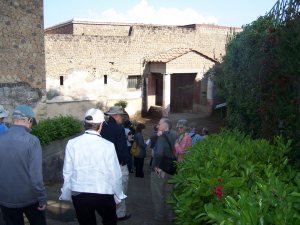
On Wednesday we turned our attention to the Campania of Antiquity, starting with the Villa San Marco of Ancient Stabiae (now Castellmare di Stabia). Before being buried by the eruption of Vesuvius, Stabiae was a luxurious Roman resort area. The Villa San Marco dates to c. 100 BCE – 79 CE, and is a very well-preserved example of early imperial luxury architecture.
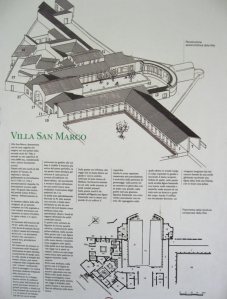
Stabiae was buried at the same time as Pompeii and Herculaneum but reemerged much earlier – at the end of Antiquity. Charles of Bourbon was also especially interested in the site.
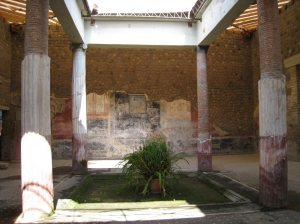
It is notable that the villa contains an atrium despite the fact that one was not necessary: the villa is outside of a city and received plenty of light. The convention is nonetheless followed in this truly lovely example.
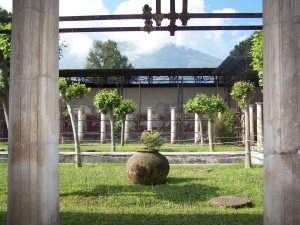
The villa also had a canal of water, with the unusual addition of a waterfall.
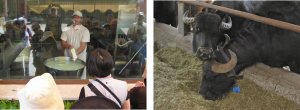
After our introduction to Antiquity, we briefly stopped at the Caseificio Vannulo to learn about the production of and to taste the famous Mozzarella di Bufala Campana. For this participant, the stop included a first – and quite surprising – encounter with a caffe latte made with buffalo milk.
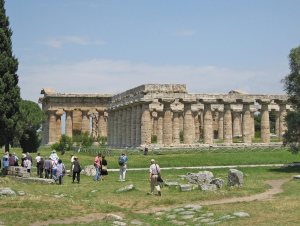
We moved on to Paestum, now known as Pesto and originally called Poseidonia by the Greeks when founded in c. 600 BCE. Seen here are the Temple of Hera I or the Basilica (front) and the Temple of Hera II or the Temple of Poseidon (left, rear). Dating to the mid-6th century BCE and the mid-5th century BCE, respectively, these two buildings are fascinating – they show the development of the Doric order in Magna Grecia, before and after the Parthenon.
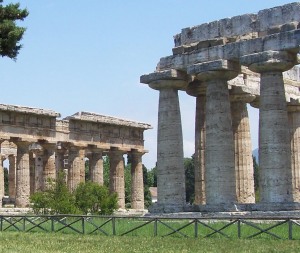
Hera I (foreground) has chubby columns and larger capitals, but we already see the use of entasis. It is an enneastyle temple, with 9 columns in the front.
Hera II (back, left) has thinner columns and a more complicated architrave. Optical corrections include the catenary curve of the stylobate. It is a hexastyle temple, with 6 columns in the front.
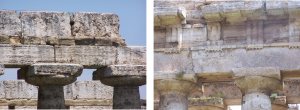
The exciting experimentation with and development of the Doric in Magna Grecia is most dramatically apparent when we look at the capitals of the two buildings: Hera I (left) and Hera II (right). Taken together, they are a truly magnificent visual expose of the architecture of Magna Grecia.
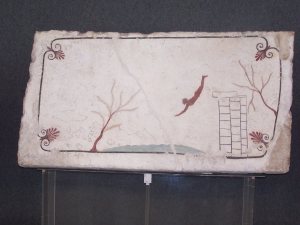
The icing on the cake in Paestum is its museum, which includes a famous early example of Ancient Greek wall painting: The Tomb of the Diver (470 BCE). Teachers beware: reproductions of this iconic image do not do it justice! The paint itself is much more matte, while the figure and setting are really quite plastic, even in two dimensions.
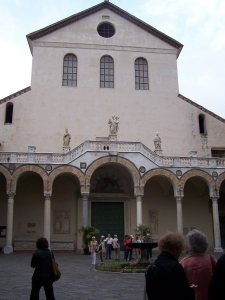
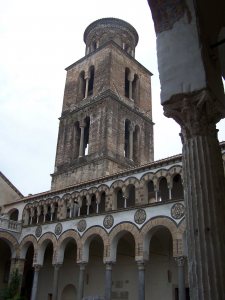
Jumping ahead in time though remaining local geographically, we moved on to Salerno Cathedral, built from 1076 to 1085 by the Norman ruler Robert II Guiscard and Bishop Alfanus, who was closely linked to Abbot Desiderius at Montecassino. As these views of the facade, atrium, and campanile show, this cathedral incorporates Early Christian, Romanesque, Byzantine, “Gothic” (“medieval modern”) and Islamic elements, as is particularly evident in its structure, decoration, and use of spolia. Viewing this coherent melange was one of the pure delights of the tour.
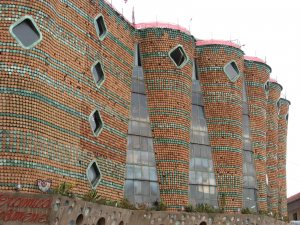
Not content with the meager span of the tour – Antiquity to the 18th century – we charged on, voracious if bedraggled, and ended the day with a visit to the Ceramica Artistica Solimene, Vietri sul Mare – a 1951 ceramics factory designed by Paolo Soleri.